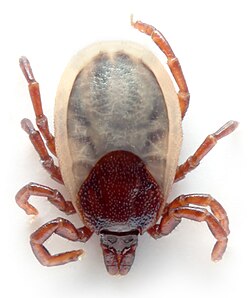Wikipedia:Featured picture candidates/Ixodes ricinus
Appearance

- Reason
- Beautiful macro photography of a very small arachnid (under half a centimetre) Given the size, the level of detail and quality is astounding.
- Articles this image appears in
- Arachnid, Tick, Parasitiformes, Ixodes ricinus
- Creator
- André Karwath
- Support as nominator Shoemaker's Holiday (talk) 01:13, 28 March 2008 (UTC)
Strong oppose-- out of focus -- 77.232.15.62 (talk) 06:28, 28 March 2008 (UTC)- IPs cannot vote. Please log in. MER-C 08:32, 28 March 2008 (UTC)
- Oppose Definitely lacks definition. --Janke | Talk 09:14, 28 March 2008 (UTC)
- Strong oppose -- out of focus -- Dmottl (talk) 11:50, 28 March 2008 (UTC)
OpposeOut of focus and blurry.--HereToHelp (talk to me) 11:53, 28 March 2008 (UTC)- Weak oppose given the size of the subject.--HereToHelp (talk to me) 15:24, 28 March 2008 (UTC)
- Oppose - The image is lifeless and awkward - lacks vibrancy. SilkTork *YES! 14:11, 28 March 2008 (UTC)
- Comment You do realise that each pixel represents less than 5 micrometres, right? This is pretty much the very edge of optical photography. Shoemaker's Holiday (talk) 15:00, 28 March 2008 (UTC)
- This incredible feat would be fully apparent if there was a scale of measurement directly in the picture instead of in the caption. Imagine how much more amazing it would look if the viewer could make that direct comparison? Enc pics should always have some kind of internal scale, whether that be a plant/tree, blades of grass, flower petals, or a simple but accurate ruler. I have no opinion either way on the technical merits, but photographers/artists should always include some kind of scale. Jeff Dahl (Talk • contribs) 01:22, 31 March 2008 (UTC)
- Support Do you guys realize that it has 4 millimetres?--Svetovid (talk) 16:23, 28 March 2008 (UTC)
- Strong support - This is not a case of technical photography. Picture of a 4 millimetres object is taken so smartly. Though it is slightly out-of-focus but because of its intellectual content I am strongly supporting its nomination. -- Niaz(Talk • Contribs) 00:20, 29 March 2008 (UTC)
- Comment I think that this would look better if it was flipped vertically. Mahahahaneapneap (talk) 02:56, 29 March 2008 (UTC)
- You may be right. The current position makes it seem like it's falling or sloped downwards.--Svetovid (talk) 11:09, 29 March 2008 (UTC)
- Flipping would swap left and right, so how about a 180˚ rotation instead?--HereToHelp (talk to me) 01:16, 31 March 2008 (UTC)
- You may be right. The current position makes it seem like it's falling or sloped downwards.--Svetovid (talk) 11:09, 29 March 2008 (UTC)
- Support Look the other way at technical issues when it's community created. --Uncle Bungle (talk) 03:32, 29 March 2008 (UTC)
- Support good but f64 is strange ... --Richard Bartz (talk) 04:24, 29 March 2008 (UTC)
- Support - masses of encyclopaedic value, visual identification at this level is especially valuable when you probably wouldn't be able to recognise the thing - or see this level of detail - if it was an inch in front of you. Guest9999 (talk) 13:46, 29 March 2008 (UTC)
- Support. A much better and more natural image than those from some electronic microscopes. --Brand спойт 19:54, 29 March 2008 (UTC)
- Oppose Image is blurry with harsh lighting. Muhammad(talk) 07:50, 30 March 2008 (UTC)
- Oppose not enough detail, focus issues. Witty Lama 08:12, 30 March 2008 (UTC)
- Condition Support upon inclusion of a scale of reference and possible 180deg rotation. The freddinator (talk) 01:43, 31 March 2008 (UTC)
- Comment It might be misleading to add a scale. Saying this tick is 4 mm long is accurate to the nearest millimetre, but a scale would imply more precision than exists. Shoemaker's Holiday (talk) 02:21, 31 March 2008 (UTC)
- The way to do this is typically to get the appropriate sized ruler, whether that be a yardstick or a microscopic ruler with tiny hash marks, and put it in to be photographed alogside the subject when the photograph is actually taken. That's the way people have been documenting natural phenomenon for a long time. Geologists, archaeologists, and crime scene technicians know exactly how important this documentation is. Even better yet would be color control patches, so we can make sure the colors are reproduced accurately as well. Additionally, actually putting it in the photo makes for a much bigger Wow! when the viewer sees just how big it is. (User:Jeff Dahl) 128.248.73.223 (talk) 16:15, 31 March 2008 (UTC)
- I am aware, but we can't really do it retrospectively, on a pre-existing three-year-old photo Shoemaker's Holiday (talk) 21:46, 31 March 2008 (UTC)
- The way to do this is typically to get the appropriate sized ruler, whether that be a yardstick or a microscopic ruler with tiny hash marks, and put it in to be photographed alogside the subject when the photograph is actually taken. That's the way people have been documenting natural phenomenon for a long time. Geologists, archaeologists, and crime scene technicians know exactly how important this documentation is. Even better yet would be color control patches, so we can make sure the colors are reproduced accurately as well. Additionally, actually putting it in the photo makes for a much bigger Wow! when the viewer sees just how big it is. (User:Jeff Dahl) 128.248.73.223 (talk) 16:15, 31 March 2008 (UTC)
- Comment It might be misleading to add a scale. Saying this tick is 4 mm long is accurate to the nearest millimetre, but a scale would imply more precision than exists. Shoemaker's Holiday (talk) 02:21, 31 March 2008 (UTC)
- Support, although I'd also suggest inverting the image. Spikebrennan (talk) 22:47, 3 April 2008 (UTC)
- Oppose Out of focus due to size --St.daniel Talk 14:33, 5 April 2008 (UTC)
Not promoted MER-C 09:30, 6 April 2008 (UTC)
